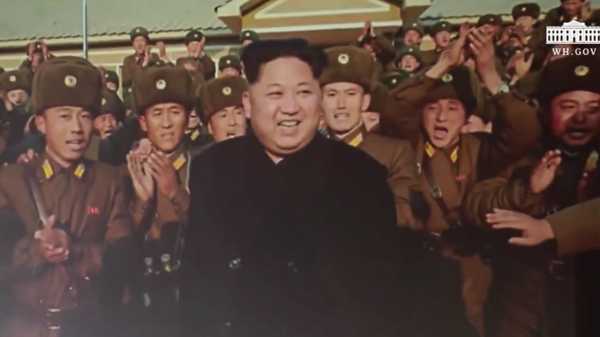
In Singapore, on Tuesday, reporters covering the summit between President Trump and the North Korean leader, Kim Jong Un, were surprised with a screening of what appeared to be a movie trailer. You could argue that, because tax dollars likely paid for the creation of the clip, we the people ought to share a producing credit. But the nature of the film—its grandiosity, its gaudiness, its chaotic logic, its indiscriminate idiocy—is such that we must understand Trump as its author.
The clip, a four-minute overture from Trump to Kim, is styled as a movie preview. A golden production logo announces this as a presentation of “Destiny Pictures,” and frequent stock footage finds the sun shining like a dime beyond the curve of a turning world. Is Trump inviting Kim to take command of Universal Pictures? Or join him in playing God? Does either of them know the difference?
In any case, the narrator insists that the fate of the world hangs in the balance, in sentences that combine pompous syntax, palatial rhetoric, and dodgy grammar. Flattering Kim’s vanity while reflecting Trump’s own, he says, “Of those alive today, only a small number will leave a lasting impact,” while crowds scurry as if in “Koyaanisqatsi,”and postcard images of tourist sites flow past—the Great Wall, the Great Pyramid, and also Times Square, because, according to Trump’s understanding of history, the visual noise of spectacle is a postmodern wonder to revere. These sights yield to a vast North Korean flag—an invitation to a tyrant to think more bigly and take his place alongside the men who built the Colosseum and the Taj Mahal.
“History may appear to repeat itself for generations,” the narrator says. “There comes a time when only a few are called upon to make a difference.” Trump appears in oratorical postures, in still photos taken at the State of the Union address and the U.N. General Assembly, manning the lectern like the Cicero of his day. Kim waves and smiles, and waves and smiles, and walks a bit and waves some more.
“Destiny Pictures presents a story of opportunity,” the narrator continues, and the viewer wonders if he’s about to hear a pitch for a time-share. It’s “a story about a special moment in time when a man is presented with one chance that may never be repeated.” The man is Kim, waving, waving. The chance is to offer his nation industrial progress and material pleasure, represented by images of a seedling, an aircraft factory, a science lab, and a double-clutch slam dunk, of course. (According to Trump’s understanding of geopolitics, his appeal to Kim as a basketball fan is the sort of personal touch necessary to achieving denuclearization.) “What will he choose?” the narrator asks. “To show vision and leadership, or not?”
The key moment of the film happens underneath that last line, at the comma. This is precisely the midpoint of the film and the fulcrum of its narrative. The prospect of Kim failing to show leadership is symbolized by the use of a burning-celluloid effect, as in Bergman’s “Persona,” or “The Muppet Movie.” We watch the film melt. The image disintegrates. The implied destruction of North Korea is figured as a disruption of the story.
“There can only be two results. One of moving back”—missiles launch, a fighter jet rises from an aircraft carrier—“or one of moving forward.” At the moving forward, the narrative is back on track, with the beep and sweep of a film leader’s black-and-white countdown. The missiles return to their silos, accompanied by what sounds like the orchestral crescendo of the Beatles’ “A Day in the Life.” In a God’s-eye view of the Korean Peninsula at night, the lights come on across the North. In a further montage of capitalist delights, Kim is shown a future of manufacturing prowess, medical advances, out-of-season fruit overflowing shopping baskets, and even the friendship of Sylvester Stallone, seen with Trump in a photo recently taken in the Oval Office.
Could it be, this audience with Sly? The narrator is cautiously optimistic: “When could this moment in history begin? It comes down to a choice on this day, in this time, at this moment. The world will be watching, listening, anticipating. . . .” The eyes and ears of the world are represented by telephoto lenses and by TV control rooms and by a woman alone on a sofa watching TV, because this is the sum of what Trump knows of persuasion.
Sourse: newyorker.com






